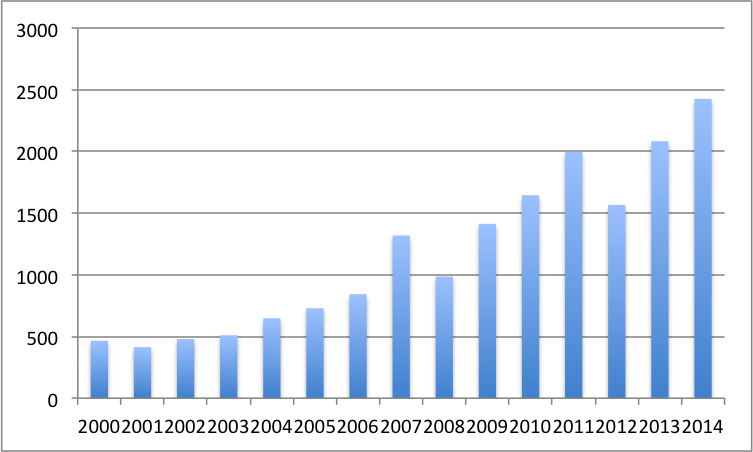June 4, 2015, by Brigitte Nerlich
Extreme weather talk: The sequel

Hydrograph of the Blanco River at Wimberley, Texas depicting the record flood event during the overnight of May 24–25
Two years ago I published a blog post on extreme weather. This showed that unlike media reporting on climate change, which has generally been going down since 2007 (with some variations and a bit of an upsurge now, see Max Boykoff’s graph at CSTPR), media reporting on ‘extreme weather’ seems to be going up more steadily.
In the context of the heat waves in India and Alaska, the drought in California, the floods in Texas and Oklahoma and now New Zealand, it’s time to revisit my June 2013 blog post and update the graphs. So, I asked myself: Is media talk about extreme weather abating? No; it’s still rising, as you can see in the figure below.
This time I only counted news items in ‘Major World Newspapers’ rather than ‘All English News’, as that was easier to do. Unlike ‘All English Language News’, the numbers here are still quite manageable for each year, only in the 2000s by 2014, which meant I didn’t have to count month by month and add up by hand. Unfortunately, Lexis Nexis doesn’t automatically display results that exceed 3000 hits.
Ideally I wanted to overlay this graph with data relating to articles on floods, droughts, heatwaves and hurricanes. However, I had to give up, as the numbers are just too high (and cumbersome to count for a quick post). If somebody has the patience to count, please go ahead. I’d love to see such a graph!
‘Extreme weather’ in Major World Newspapers, Lexis Nexis, High similarity setting
Weather and climate
Two years ago I still wondered whether talking about ‘extreme weather’ was just a good way of making climate change public, or whether talking about ‘extreme weather’ was becoming a place where we talk about the reality of climate change.
According to NASA, “[w]eather is what conditions of the atmosphere are over a short period of time, and climate is how the atmosphere ‘behaves’ over relatively long periods of time.” However, if, according to NASA, weather is “basically the way the atmosphere is behaving, mainly with respect to its effects upon life and human activities” and “climate is how the atmosphere ‘behaves’ over relatively long periods of time”, then I think both types of ‘behaviours’, one (weather) marked by ‘extremes’ and the other (climate) by increasing ‘chaos’, are now converging. This also means that extreme weather talk will be merging with climate change talk. That’s not quite happening yet, I have the impression, but I think its only a matter of time. Ask me in two years!
[It is now two years later, April 2017 and some extreme weather events are now being attributed to climate change]
For some more in-depth reflections on the complex links between extreme weather events and climate change, you may want to read this article by Chris Mooney which came out while I was typing this post.
Image: Hydrograph of the Blanco River at Wimberley, Texas depicting the record flood event during the overnight of May 24–25


Roger Pielke discusses this issue in his new book “The Rightful Place of Science: Disasters and Climate Change”. Apparently it contains a graph similar to the one you show here. Perhaps we should get a copy for the University library!
Ah I’ll try and ferret that out!